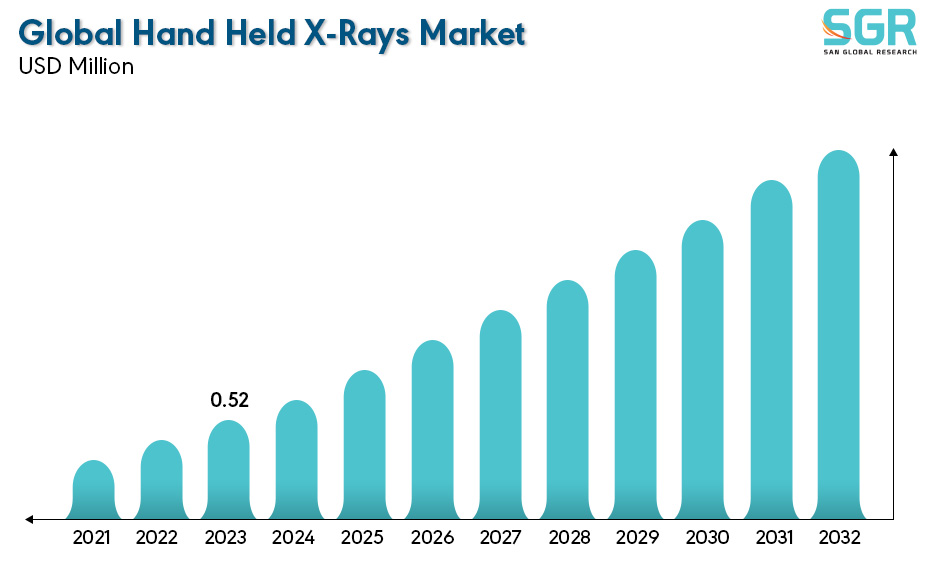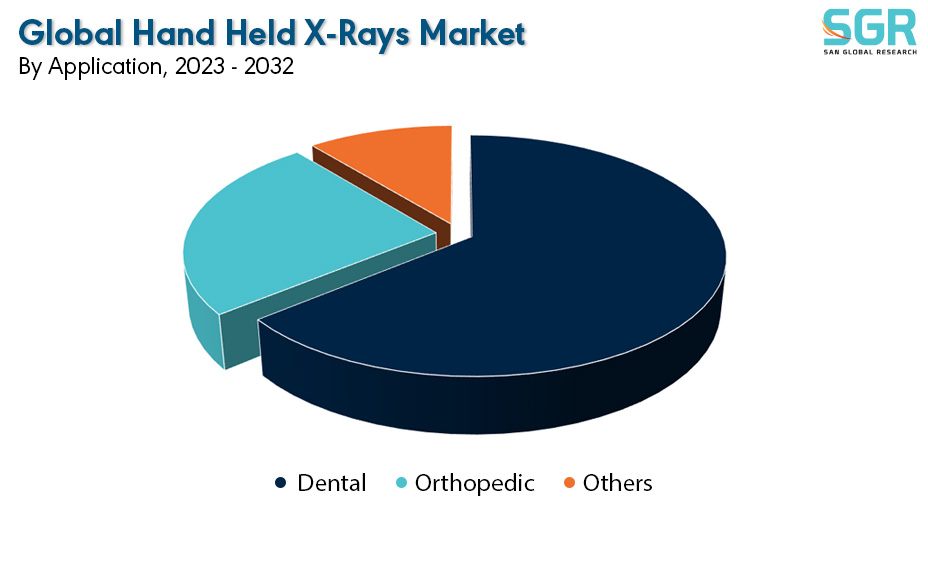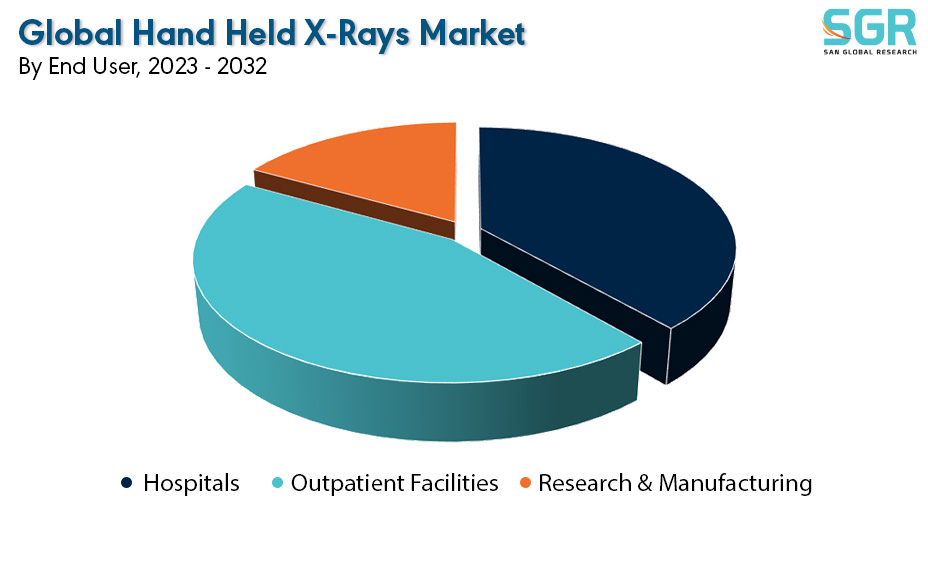Global Hand Held X-Rays Market is estimated to be worth USD 0.52 Billion in 2022 and is projected to grow at a CAGR of 9.2% between 2023 to 2032. The study has considered the base year as 2022, which estimates the market size of market and the forecast period is 2023 to 2032. The report analyzes and forecasts the market size, in terms of value (USD Billion), for the market. The report segments the market and forecasts it by application, by end use and by region/country.

the handheld X-rays market has been witnessing notable advancements and increasing demand for portable diagnostic imaging solutions. These handheld devices offer the convenience of on-the-go imaging, enabling healthcare providers to conduct X-ray examinations at the point-of-care or in remote settings with greater flexibility. The compact size, portability, and ease of use make handheld X-ray devices particularly beneficial in emergency situations, home healthcare, veterinary practices, and scenarios where traditional fixed X-ray machines are not feasible. Additionally, advancements in technology have led to improvements in image quality, radiation safety features, and connectivity options, enhancing their diagnostic capabilities and usability. The market has seen growing interest and investments from key players aiming to capitalize on the expanding need for mobile diagnostic solutions. However, regulatory considerations regarding radiation exposure, reimbursement challenges, and the need for further advancements in image quality and user-friendliness continue to be factors influencing the market's growth and adoption.

Region Wise Comparison:
North America held a considerable share in the handheld X-rays market. The region's well-established healthcare infrastructure, technological innovation, and a high adoption rate of advanced medical devices contributed to the market's growth. The United States, in particular, showed a significant uptake of portable X-ray devices in various healthcare settings.
Europe also demonstrated a notable presence in the handheld X-rays market. Countries within Europe have advanced healthcare systems and a growing demand for portable imaging solutions in emergency care, home healthcare, and veterinary practices. The region's emphasis on technological advancements and regulatory compliance further supported market growth.

The handheld X-rays market in the Asia-Pacific region exhibited considerable growth potential. Increasing healthcare expenditure, improving healthcare infrastructure, and a rising demand for point-of-care diagnostic solutions contributed to the market's expansion. Countries like China, Japan, and India were key contributors to the growth of portable X-ray devices in this region.
Latin America showed a growing interest in handheld X-ray devices, driven by improving healthcare access, increasing awareness of portable diagnostic solutions, and a need for mobile imaging in remote areas. Brazil, Mexico, and Argentina were among the countries witnessing growth in the adoption of these devices.
The handheld X-rays market in these regions was gradually evolving due to efforts to improve healthcare infrastructure, increase access to medical technology, and address healthcare challenges in remote areas. However, market penetration might have varied due to economic constraints and regulatory factors.

Segmentation:
The Global Hand Held X-Rays Market is segmented by application, by end use and by region/country.
By Application:

- Based on the Application, the Global Hand Held X-Rays Market is bifurcated into Dental, Orthopedic & Others – where the Dental is dominating and ahead in terms of share.Handheld X-ray devices designed specifically for dental imaging have gained traction due to their portability, ease of use, and effectiveness in providing on-the-spot diagnostic capabilities in dental offices or during chair side procedures. These devices offer dentists the convenience of obtaining immediate X-ray images, aiding in the assessment of oral health conditions, including caries detection, periodontal diseases, root canal treatments, and implant placements. Moreover, handheld dental X-ray devices contribute to reduced radiation exposure compared to traditional X-ray machines, enhancing patient safety while providing high-quality diagnostic imaging. The dental type in the handheld X-rays market continues to evolve with ongoing technological advancements, focusing on improved image quality, radiation safety features, and ergonomic designs tailored to meet the specific needs of dental practitioners, thereby enhancing diagnostic precision and treatment planning in dental care settings.
By End Use:

- Based on the end use, the Global Hand Held X-Rays Market is bifurcated into Hospitals, Outpatient Facilities and Research & Manufacturing– where Hospitals is dominating and ahead in terms of share.
On the basis of region
- North America
- Europe
- Asia Pacific
- South America and
- Middle East and Africa
In 2022, North America is anticipated to dominate the Global Hand Held X-Rays Market with market revenue of XX USD Million with a registered CAGR of XX%.
Key Players:
The key market players operating in the Global Computer Aided Engineering Market include.
- DENTAL IMAGING TECH CORP.
- REMEDI CO.
- GENORAY
- OXOS MEDICAL
- MAXRAYCOCOON
- DIGITAL DOC
- EVIDENT
- CARESTREAM DENTAL
Drivers:
Growing sector across the globe
Several key drivers contribute to the growth and adoption of handheld X-ray devices in the market. One significant driver is the increasing demand for portable and point-of-care diagnostic imaging solutions across various healthcare settings, including emergency care, home healthcare, dental practices, and veterinary clinics. The convenience and flexibility offered by handheld X-ray devices for immediate imaging needs, especially in situations where traditional fixed X-ray machines are impractical, drive their adoption. Additionally, technological advancements leading to improvements in device portability, image quality, radiation safety features, and connectivity options further propel the market. Rising awareness of the advantages of portable X-ray devices, such as reduced patient wait times, enhanced workflow efficiency, and lower radiation exposure, contributes to increased acceptance among healthcare providers. Moreover, regulatory initiatives promoting the use of portable imaging devices and the ongoing efforts by manufacturers to innovate and develop user-friendly, cost-effective, and reliable handheld X-ray solutions play a significant role in driving the market's growth.
Opportunity:
Evolving Market
The handheld X-rays market presents numerous opportunities that promise to further expand its growth and influence in the healthcare industry. One significant opportunity lies in the continual technological advancements aimed at enhancing the performance and capabilities of portable X-ray devices. Innovations focusing on improved image quality, radiation safety features, and connectivity options will further enhance the diagnostic capabilities of handheld X-ray units, opening avenues for wider adoption in various healthcare settings. Expansion into emerging markets, particularly in regions with developing healthcare infrastructure, offers substantial growth prospects. The rising demand for mobile and point-of-care diagnostic solutions in these regions, coupled with increasing healthcare expenditure, creates opportunities for the penetration of handheld X-ray devices. Furthermore, the growing trend of telemedicine and home healthcare services presents an opportunity for handheld X-ray devices to play a crucial role in delivering diagnostic imaging directly to patients' homes, thereby enhancing accessibility to healthcare services. Collaboration among industry players, academic institutions, and healthcare providers to develop tailored solutions meeting specific clinical needs will further unlock opportunities for innovative applications of handheld X-ray technology, thus driving market growth.

 Description
Description
 Gera Imperium Rise,
Gera Imperium Rise,  +91 9209275355
+91 9209275355


